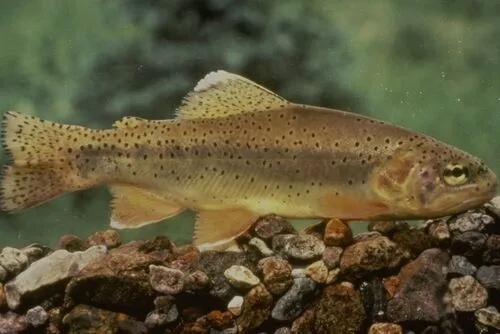
Photo Credit: USFWS
On August 11, 2023, the U.S. Fish and Wildlife Service (Service) published a proposed rule to delist the Apache trout (Oncorhynchus apache) under the Endangered Species Act (ESA) due to the species’ recovery. The Apache trout, the state fish of Arizona, is a species of freshwater fish that is found primarily in the mountain region of southeast Arizona. This species was initially listed as an endangered species under the ESA in 1967. Then, in 1975, the Service downlisted the species to threatened status. The ESA defines a threatened species as one that is “likely to become endangered in the foreseeable future throughout all or a significant portion of its range.”
The regulations implementing the ESA provide for three circumstances when a species shall be delisted: “(1) the species is extinct; (2) the species does not meet the definition of an endangered or a threatened species; and (3) the listed entity does not meet the definition of a species.” The Service is required to delist a threatened species if it determines on the basis of the best available scientific and commercial data, that the species is no longer threatened. In the proposed rule, the Service states that the Apache trout no longer meets the definition of a threatened species because the trout’s various threats have been eliminated or reduced to the point that it no longer meets the definition of a threatened or endangered species.
One of the Service’s guiding considerations in its proposal to delist the Apache trout is the species’ successful recovery when measured against criteria articulated in the species’ recovery plan. Pursuant to section 4(f) of the ESA, the Service developed a recovery plan for the Apache trout in 2009 to guide and track the species’ recovery and conservation. In the proposed rule, the Service recognizes that meeting the criteria of the recovery plan is not the only way that a species may qualify for delisting, however, the Service states that the criteria are helpful in guiding the agency’s determination.
The Apache trout’s recovery plan identifies four criteria to measure the species’ recovery: (1) the existence of sufficient habitat for all life stages of 30 self-sustaining, discrete Apache trout populations; (2) the establishment of 30 discrete populations of genetically pure Apache trout; (3) the implementation of angling regulations to protect the Apache trout; and (4) the establishment of agreements with state agencies to monitor and conserve the species. According to the Service, the Apache trout has now met three out of its four recovery criteria, with the final criterion (establishment of 30 discrete, genetically pure populations) nearly met; there are currently 29 discrete populations of genetically pure Apache trout.
The Service recognizes that while long-term threats to the species such as nonnative trout, climate change, and wildfires may continue to persist, the Service states it will continue to monitor the species after its delisting to identify future concerns. If the Service publishes a final rule delisting the Apache trout, two immediate consequences would follow. First, the ESA section 4(d) rule that prohibits certain types of take of the Apache trout would no longer apply to the species. Second, federal agencies would no longer be required to consult with the Service under ESA section 7 if an activity that the federal agency is authorizing, funding, or carrying out may impact the Apache trout. The Service is currently accepting public comments on the proposed delisting rule until October 10, 2023.
- Associate
Noah DeWitt assists clients on a full range of environmental and land use law matters. Noah has experience conducting legal research and drafting memorandum regarding issues related to CEQA development compliance, local zoning ...
Nossaman’s Endangered Species Law & Policy blog focuses on news, events, and policies affecting endangered species issues in California and throughout the United States. Topics include listing and critical habitat decisions, conservation and recovery planning, inter-agency consultation, and related developments in law, policy, and science. We also inform readers about regulatory and legislative developments, as well as key court decisions.
Stay Connected
 RSS Feed
RSS Feed
Categories
- Alternative Energy
- Bald and Golden Eagle Protection Act
- Budget
- CEQA
- CESA
- Climate Change
- Congress
- Conservation
- Construction Projects
- Consultation
- Continuing Education
- Court Decisions
- Critical Habitat
- Delisting
- Endangered Species Act
- Event
- Fish & Wildlife Service
- Freedom of Information Act
- Government Administration
- Legal
- Legislation
- Listing
- Litigation
- Migratory Bird
- National Marine Fisheries Service
- NEPA
- Off Shore Wind
- Pacific Northwest
- project
- Publications
- Regulatory Reform
- Sacramento-San Joaquin Delta
- SEPA
- Speaking Engagements
- Supreme Court
- Texas
- Timberland
- Water Issues

